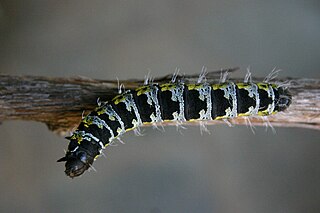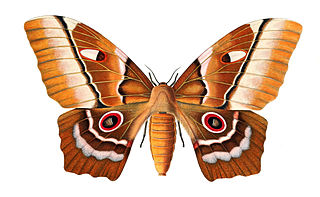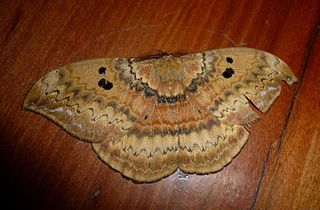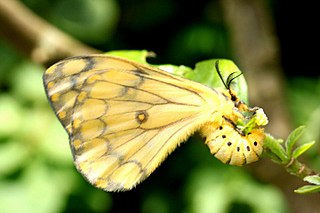| Carnegia | |
|---|---|
 | |
| From Cameroon | |
| Scientific classification | |
| Kingdom: | |
| Phylum: | |
| Class: | |
| Order: | |
| Superfamily: | |
| Family: | |
| Genus: | Carnegia Holland, 1896 |
Carnegia is a genus of moths in the family Saturniidae first described by William Jacob Holland in 1896. [1] [2]
| Carnegia | |
|---|---|
 | |
| From Cameroon | |
| Scientific classification | |
| Kingdom: | |
| Phylum: | |
| Class: | |
| Order: | |
| Superfamily: | |
| Family: | |
| Genus: | Carnegia Holland, 1896 |
Carnegia is a genus of moths in the family Saturniidae first described by William Jacob Holland in 1896. [1] [2]

Saturniidae, members of which are commonly named the saturniids, is a family of Lepidoptera with an estimated 2,300 described species. The family contains some of the largest species of moths in the world. Notable members include the emperor moths, royal moths, and giant silk moths.

Caligula is a genus of moths of the family Saturniidae. It is primarily an Oriental genus, found in India, China and Southeast Asia. The genus is often treated as a synonym of Rinaca. It is named after Roman emperor Caligula.

Cirina is a genus of moths in the family Saturniidae.

Rohaniella is a genus of moths in the family Saturniidae. The genus was erected by Eugène Louis Bouvier in 1927.

Pseudimbrasia is a monotypic moth genus in the family Saturniidae described by Pierre Claude Rougeot in 1962. Its only species, Pseudimbrasia deyrollei, described by James Thomson in 1858, is found in the mid-latitudes of Africa.

Rohaniella pygmaea, the pigmy emperor, is a moth of the family Saturniidae. It is found in Africa, including Namibia and South Africa. The species was first described by Peter Maassen and Gustav Weymer in 1885.

Automeris is a genus of moths in the family Saturniidae and the subfamily Hemileucinae. As of 1996 there were 124 species, and more have since been described. These moths are generally characterized by the eyelike patches on the hindwings and the leaflike pattern on the forewings, an example of crypsis. The genus was first described by Jacob Hübner in 1819 and it is distributed in the Neotropical realm.

Aglia is a genus of moths in the family Saturniidae first described by Ochsenheimer in 1810. It is the only genus in the subfamily Agliinae.

Janiodes is a genus of moths in the family Saturniidae first described by Karl Jordan in 1924.

Microdulia is a genus of moths in the family Saturniidae first described by Karl Jordan in 1924. It contains only one species, Microdulia mirabilis, described by Rothschild in 1895, which is found between 35° and 47°S in Chile and Neuquén in Argentina.
Catharisa is a genus of moths in the family Saturniidae first described by Karl Jordan in 1911.

Hemileuca is a genus of moths in the family Saturniidae first described by Francis Walker in 1855.

Hyalophora is a genus of moths in the family Saturniidae. The genus was erected by James Duncan and John O. Westwood in 1841.

Aurivillius is a genus of moths in the family Saturniidae first described by Alpheus Spring Packard in 1902. They occur in Sub-Saharan Africa.

Vegetia is a genus of moths in the family Saturniidae first described by Karl Jordan in 1922.

Rothschildia orizaba, the Orizaba silkmoth, is a moth in the family Saturniidae. The species was first described by John O. Westwood in 1854. It is found in Mexico, Central and South America.
Gonimbrasia tyrrhea, the zigzag emperor moth, is a moth of the family Saturniidae. The species was first described by Pieter Cramer in 1776. It is found in central and southern Africa.
Correbia negrona is a moth of the subfamily Arctiinae. It was described by Max Wilhelm Karl Draudt in 1917. It is found in Ecuador.
Cricula ceylonica, the Sri Lankan cricula silkmoth, is a moth of the family Saturniidae. The species was first described by Karl Jordan in 1909 and it is endemic to Sri Lanka. The debate of this species with much broader range circular species - Cricula trifenestrata is not yet fully understood. However, Rougerie et al., in 2009 considered Cricula ceylonica a valid species, probably endemic to Sri Lanka.

Pseudaphelia apollinaris is a species of moth in the family Saturniidae first described by Jean Baptiste Boisduval in 1847.